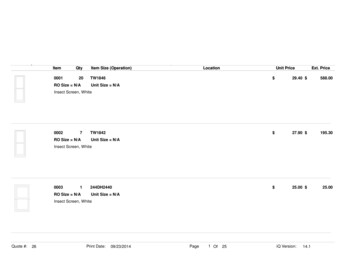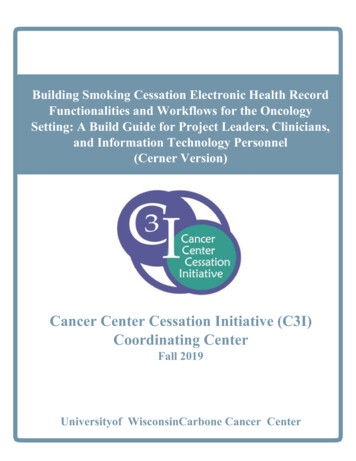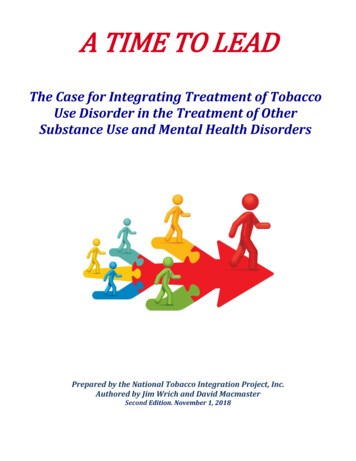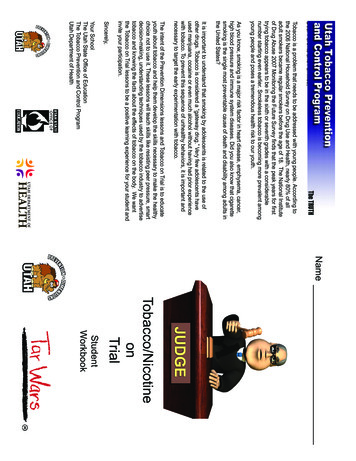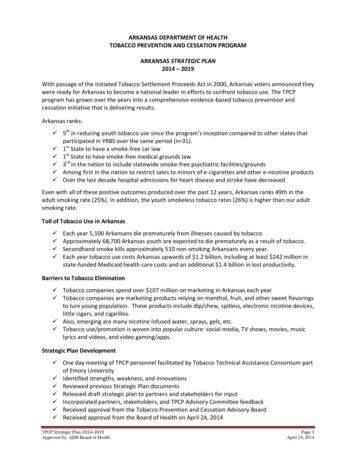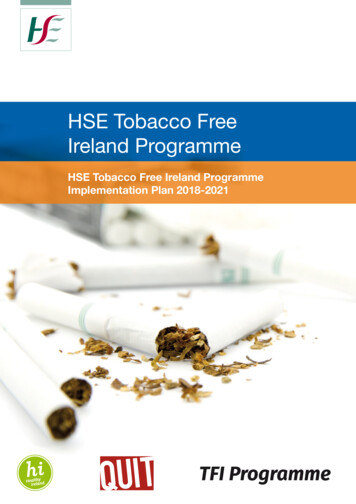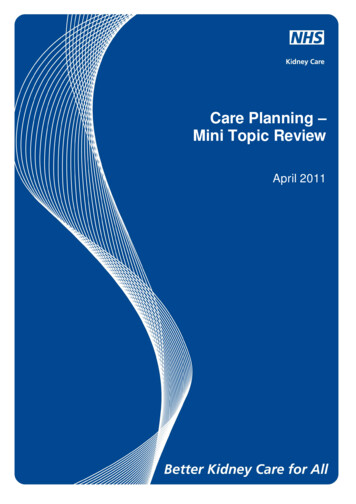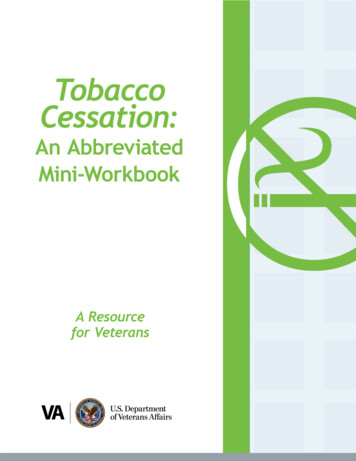
Transcription
TobaccoCessation:An AbbreviatedMini-WorkbookA Resourcefor Veterans
Table of ContentsCHAPTER 1: Introduction.1CHAPTER 2: Why Do I Use Tobacco?.3CHAPTER 3: Nicotine Addiction.6CHAPTER 4: Medications To Help You Quit Tobacco. 11CHAPTER 5: Getting Ready For Quit Day!. 12CHAPTER 6: Quit Day. 18CHAPTER 7: The First Two Weeks After Quit Day. 21Tobacco Cessation Resources. 23Appendix A. 24This mini-workbook is an abbreviated version of the Tobacco& Health Primary Care Tobacco Cessation program book “MyTobacco Cessation Workbook.” It is intended to be used byVeterans involved in telephone, telehealth, or secure messagebased tobacco cessation programs. Veterans prescribed tobaccocessation medications should be given individual medicationhandouts as this mini-workbook does not contain in-depthmedication information.Download patient medication guides here: spU.S. Department of Veterans AffairsVeterans Health AdministrationWashington, DC 20420Tobacco Cessation:An Abbreviated Mini-WorkbookJuly 2015
CHAPTER 1: IntroductionCHAPTER 1: IntroductionCongratulations on taking the first step to quitting tobacco products. Whether yousmoke cigarettes, cigars, pipes or use chewing tobacco, VA’s Primary Care TobaccoCessation Program can help you quit. Smoking is the number one cause of preventableillness in the United States. Smoking increases your chance of having a heart attack andstroke and it can damage your lungs and in many cases, lead to emphysema. Smokingcan also cause cancer of the lungs, bladder, kidney, and pancreas as well as causecancer in the mouth and throat.If you have tried to quit before and have not been successful, don’t give up! Researchhas shown that it takes an average of 6-8 quit attempts for a smoker to quit for good.Think of tobacco dependence as a chronic disease like high blood pressure or highcholesterol you will need to work at it to become a nontobacco user.So what is the best way to quit tobacco? People ask this question all the time and thereare multiple ways you can stop. The best way to stop tobacco is to use behavioraltechniques to help you break the habit and develop new behaviors, along withmedications to help you manage nicotine withdrawal symptoms. This mini-workbook,written specifically for Veterans, will assist you in changing your daily behaviors thatup until now have resulted in your use of tobacco products.11
CHAPTER 1: IntroductionWHY DO I WANT TO QUIT TOBACCO?The first step in quitting any addictive drug, including nicotine, is to determine why youwant to quit.Mark off the reasons you want to quit tobacco products: Breathe better Reduce my risk of cancer Reduce my risk of heart attack and stroke Improve circulation of blood to my legs and arms Reduce my risk of emphysema/chronic bronchitis, chronic obstructive pulmonarydisease (COPD) Smell better Improve my sense of smell and taste Save money Set a good example for my children/grandchildren Have more control over my lifeWhat are other reasons you want to quit? Write these reasons below:2
CHAPTER 2: Why Do I Use Tobacco?CHAPTER 2: Why Do I Use Tobacco?TOBACCO USE IS LINKED TO OTHER HABITSTobacco use is associated with several different behaviors that are very closely related.Tobacco use is a learned behavior, meaning you learned this from your family, friends,magazine ads, television, movies, or during your military service. When you were inthe military, you may have heard someone say “Smoke ‘em if you got ‘em.” Who helpedyou learn your tobacco habit?Think about how often you “puff” or “drag” on a cigarette in a day. If you smoke onepack of cigarettes a day and each cigarette takes 10 puffs, that’s 200 puffs a day. Overthe course of 40 years, you would take approximately three million puffs!Tobacco use is also a triggered behavior, meaning certain activities or times of day maymake you think about having a cigarette or chewing tobacco.Check off some of your triggers for using tobacco: Waking up in the morning After meals During breaks Driving Talking on the phone Working on the computer Drinking coffee Drinking alcohol After sex Before bedtime Waking up during the night, havingnightmares Stress Pain Feeling anxious, angry or impatient Seeing someone else smoke Feeling bored Watching TV After completing a taskWrite down other triggers you may have:3
CHAPTER 2: Why Do I Use Tobacco?A CHALLENGE FOR YOU: ADDRESSING YOUR TRIGGERSTry not smoking during one of your triggers. For example, you might pick after eatingbreakfast as the trigger. Starting tomorrow, try not smoking for 10 minutes after breakfast.Wait 20 minutes to smoke after breakfast the next day. Wait 30 minutes the day after that.Add another 10 minutes each day. By the end of the week you will be waiting one hourbetween the trigger and smoking. Once you have tackled one trigger, try adding anothertrigger until you have a few of them managed.By adding time between the trigger and the action of using tobacco, the trigger becomesweaker. This will help when you get to your quit day. If you use chewing tobacco, you cando the same thing by looking at your triggers to put in a new dip. To help you avoid usingtobacco, come up with a few things you can do rather than use tobacco.Some examples would be:Goingfor a walkUsinga substitute like chewing gum or candyDoingdeep breathing exercises (see Appendix A)A more complete list of substitute behaviors can be found under DEADS Strategy on p.15.Write down 3 of your triggers and what you will do instead of using tobacco:1. Trigger:Instead of using tobacco, I will:2. Trigger:Instead of using tobacco, I will:3. Trigger:Instead of using tobacco, I will:Lastly, tobacco use is also an automatic behavior, meaning you may find you smoke withoutthinking about it. You may recall times when you lit a cigarette and then noticed you alreadyhad one lit.4
CHAPTER 2: Why Do I Use Tobacco?There are a few ways to help reduce this automatic behavior:Tip #1 Move your tobacco to a different locationIfyou carry your cigarettes in your front pocket, put them on the kitchen counter. Ifyou smoke outside, take one cigarette with you instead of the whole pack. You willneed to physically walk to the pack to smoke the next cigarette. This leads you tothink about smoking that cigarette and possibly consider whether you really need itor if you can wait longer to have the next one.Ifyou use chewing tobacco, try placing the can on the kitchen counter or anotherlocation in the house, rather than in your pocket. You will need to walk to thelocation of the tobacco can before putting in a new plug of chew.Tip #2 Keep track of your cigarettes as you smoke themTrackyour tobacco use on a sheet of paper you keep in your pocket or in your packof cigarettes. Each time you smoke or dip, note on your tracker the time of day, yourmood at that time (e.g., happy, bored, angry, etc.) and your level of need for tobacco(e.g., low, medium, high).Keepingtrack of the cigarettes helps you work on the automatic behavior of smoking.You can see if changes in your mood cause you to smoke more or less. Many peoplefind that they smoke more when they are unhappy, while others might find theysmoke more when they are bored. Times of celebration may be a situation when yourtobacco use might increase. You may find that you smoke more when you are aroundcertain friends who also smoke.Ifyou use chewing tobacco, you can use the same method to track the number ofdips you take in a day.5
CHAPTER 3: Nicotine AddictionCHAPTER 3: Nicotine AddictionWHAT IS NICOTINE?Nicotine is a substance found naturally in tobacco that causes feelings of pleasure,relaxation or stimulation, and stress reduction. Nicotine is the addictive part of tobacco,but is not by itself harmful to your body. The other substances found in tobacco andsubstances formed when tobacco is burned harm your body. There are more than 7,000chemicals in tobacco smoke and at least 69 that are harmful to humans and can causecell damage, cell death and cancer. Some of the more harmful chemicals include en though it is not burned, smokeless tobacco also contains some of these harmfulchemicals. Other products and devices that deliver nicotine, including the electroniccigarette, may also be harmful to you.Some products with nicotine can help you quit using tobacco, like nicotine replacementtherapy (nicotine patch, nicotine gum, and nicotine lozenges). It is important to only usenicotine products to quit that are approved by the U.S. Food and Drug Administration(FDA).COPING WITH NICOTINE WITHDRAWALNicotine is one of the most addictive substances on earth and this is why it is so hardto quit. You feel a need for a cigarette when the level of nicotine in your body startsto drop. If you go for long periods of time between cigarettes, such as sleeping throughthe night, you will have a strong craving to smoke.You might feel the following effects when you are low on nicotine:Irritability,frustration, essedCravings/urgesmoodnose
CHAPTER 3: Nicotine AddictionMost of these symptoms start the first or second day you are off tobacco. They are at theirworst in the first week and get better with time. Most symptoms disappear after 2-4 weeks,but the urge to smoke can stay with you for a long time. The urge to use tobacco will bestronger when you first quit and seem to last minutes. However, after the first 2-4 weeks,the urges will become shorter. For most people the urge lasts only seconds after they havebeen off tobacco for a month or longer. Nicotine withdrawal symptoms can be managed bycertain medications and behavioral coping strategies.Table 1. Behavorial Strategies for Coping with Nicotine Withdrawal SymptomsWithdrawal SymtomsAvoid stressPractice relaxation techniquesExerciseDo something funGet support from family and friendsDiscuss with your medical providerAvoid stressPlan your work accordinglyDizzinessGet up slowly from sitting positionChest tightnessPractice relaxation techniquesGet more sleepTake napsDon’t push yourselfDrink lots of waterEat low-calorie snacksDrink fluidsEat fruits and vegetablesDrink fluidsEat sugar-free candyUse cough dropsReduce caffeine consumption (e.g., reducedaily intake by 50%)IrritabilityDepressed moodDifficulty concentratingFatigueHungerStomach pain, constipation, gasCough, dry throat, runny noseDifficulty sleeping7What Can I Do About It?
CHAPTER 3: Nicotine AddictionHOW TOBACCO AFFECTS YOUR BODYTobacco can be harmful to almost every part of your body. Many of these problems can becompletely or almost completely reversed if you stop tobacco. Here is a list of the mostcommon problems of tobacco use going from your head to your toes:HeadStroke (blockage or breaking of a blood vessel in the brain)Mouth and throat cancersCavities and loss of teethBad breathDecreased night visionYellow staining of skin and teethNose congestion and infectionsWrinklesLungsCancer (up to 85% of all lung cancersare from smoking)Emphysema and chronic bronchitisWorsening of asthmaLung infectionsHeartCongestive heart failureHeart attacksIncreased blood pressure and heart rateStomach/intestines8CancersUlcersHeartburn
CHAPTER 3: Nicotine AddictionPancreasCancerCirculation in arms, legs and feetReduced circulation in arms, legs and feet that sometimes leads to amputations insevere casesBonesIncreased bone thinning leading to a higher risk of broken bonesGenitals/urinary systemCancers in kidneys, bladder and reproductive organsErectile dysfunction in menSexual dysfunction in womenRECOVERY OF YOUR BODY AFTER STOPPING TOBACCOAfter you quit using tobacco products, your body will start to heal and you will start seeingmany improvements. It is never too late to quit. You will start seeing benefits the veryfirst day you quit using tobacco and these benefits will increase the longer you remaintobacco free.20 minutes after you quitReduction in your heart rate and blood pressure; the temperature of your hands and feetwill start returning to normal.12 hours after you quitCarbon monoxide level in your blood drops.24 hours after you quitAnxiety and irritability may start due to withdrawal from nicotine. These symptoms getbetter the longer you are off tobacco.2—3 days after you quitNerve endings in your body start to regenerate and you may notice a return in your tasteand smell. Anger, anxiety and irritability from nicotine withdrawal may be at the worstlevel during this time. Nicotine replacement with nicotine gum or lozenges may help this.Breathing may be easier now.1 week after you quitTobacco cravings and urges may be less frequent and shorter in duration.9
CHAPTER 3: Nicotine Addiction2 weeks after you quitBlood circulation in your gums and teeth are similar to a nonsmoker. You should no longerhave anger, anxiety and irritability from nicotine withdrawal. Cravings and urges should beshorter and less frequent.1—3 months after you quitYour heart attack risk has started to drop and your lung function is improving. The bloodcirculation in your body has improved and walking might be easier. Give walking a tryand see if you can go farther than when you were smoking. If you had a cough when yousmoked, the cough should be gone now.1—9 months after you quitSmoking-related nasal congestion, fatigue, and shortness of breath should be improving.Cilia (little hairs in the lungs, throat and nose) have re-grown in your lungs and can cleanyour lungs to remove irritants and mucous, and reduce infections.1 year after you quitThe risk of cardiovascular disease, heartattack, and stroke has dropped to less thanhalf that of a smoker.10—15 years after you quitYour risk of having a stroke or heart attackhas dropped to a similar rate as a nonsmoker.Your risk of lung cancer is 30-50% less than acontinuing smoker’s risk. Your risk of deathfrom lung cancer is one-half of the risk if youwere an average smoker (one pack per day).Your risk of pancreatic cancer is similar to aperson who has not smoked and your risk ofmouth, throat, and esophageal cancer hasreduced significantly.Your risk of tooth loss has decreased toa rate similar to someone who has neversmoked.20 years after you quit (women)Your risk of death from smoking-relatedcauses, including cancer and lung disease, isthe same as a person who never smoked.1020 minutes to 20 years.Benefits of quitting smokinglast a lifetime
CHAPTER 4: Medications to Help You Quit TobaccoCHAPTER 4: Medications To Help YouQuit TobaccoTYPES OF TOBACCO CESSATION MEDICATIONSThere are many types of medications used to help people quit tobacco. Some of thesemedications provide nicotine to help you slowly reduce the nicotine level in yourbody when you quit tobacco. Medications that provide nicotine are called nicotinereplacement therapy (NRT). NRT reduces your cravings for nicotine and helps reducenicotine withdrawal symptoms. There are also two medicines, bupropion (Zyban ) andvarenicline (Chantix ), which do not contain nicotine, but can help you have fewernicotine cravings.All medications are effective in increasing your chances of stopping tobacco for good.The medications listed below are available through VA. Contact your primary careprovider or mental health provider if you are interested in using medications to helpyou quit tobacco.1. Nicotine replacement therapy (NRT) Nicotine patch Nicotine lozenge Nicotine gum2. Bupropion (Zyban , Wellbutrin )3. Varenicline (Chantix )Some of these medications can be used together to help you stop tobacco. Manystudies have shown that these combinations are effective and can work better thanusing one medication alone.Combination therapy:Nicotine patch BupropionNicotine patch Nicotine gumNicotine gum BupropionNicotine patch Nicotine lozengeNicotine lozenge BupropionNote: Varenicline is not used in combination with any other medication for quitting tobacco.You may be wondering “What works best?” when it comes to quitting tobacco. At thistime, it appears that combination therapy using the medications listed above alongwith behavioral strategies have the highest success rates. For most patients, the choiceof medication will be based on your medical history, which you can discuss with yourmedical provider.11
CHAPTER 5: Getting Ready for Quit Day!CHAPTER 5: Getting Ready For Quit Day!SET YOUR QUIT DAYAs your quit day approaches, there are several things you might want to do to getready.First, write down your quit day this date is very important!MY QUIT DAYMonth DayYearTimePLANNING FOR QUIT DAYNow get your home, car and workplace ready for quitday by following the tips below:1. Plan out your tobacco usage so you will runout by your quit day. Make sure you removeall tobacco from your home. Look in jacketpockets, kitchen drawers, the freezer,your garage, or other frequent tobaccostorage sites. Also check inside your car forany stashes of tobacco. Considering thatthe average craving for tobacco lasts 2-3minutes, removing nearby tobacco productswill keep you from being tempted. For mostfolks, the urge may pass before you can getin the car and go to a store to buy tobacco.2. Remove all ashtrays and lighters. These canbe triggers for tobacco use once you get to quit day. Since your plan is toquit, do you really still need them? Remove ashtrays and lighters in the caras well.3. Clean up your smoking area. If you smoke in one room (e.g., porch, garage)or in the car, clean up these locations as they can be triggers for you tosmoke. Remove cigarette butts, wash down furniture, and spray upholsterywith an odor neutralizer to help remove the smoke smell. Getting your carcleaned or detailed may help. You may find you have trouble spending timein these areas for a while. That is ok, just take a break and come back whenyou have a few weeks of being tobacco free.12
CHAPTER 5: Getting Ready for Quit Day!4. Go to the store and stock up on some tobacco substitutes. Sugar-free gum,sugar‑free mints or candies, carrot and celery sticks or other vegetables,toothpicks, straws, and cinnamon sticks. These items can be helpful when youare having a craving.5. Think about hobbies or other interests you have to fill up your day. Some hobbiesand interests to consider would be puzzles, games, reading, exercise, fishing,woodworking, painting, drawing, and cooking. Make sure it is a hobby notassociated with tobacco use.When you are planning to quit, it is first good to look at your habits and patterns of usingtobacco. Pick three times you use tobacco and write these down.Write an activity you can do or a substitute you could use instead of using tobacco. Forexample, if you use tobacco after meals, brush your teeth instead of smoking. Examples ofactivities and substitutes are:ChewingUsingsugar-free gumsugar-free candyChewingon a straw or toothpick(don’t swallow pieces of toothpick)Eatingcarrot sticks or celery sticksDrinkingwaterGoingfor a walkDoingchair exercisesDeepbreathingTalkingto a friendReadinga bookWorkingon a crossword puzzlePlayingcomputer gamesBrushingyour teeth1. I usually smoke when:Instead of smoking at that time, I can:13
CHAPTER 5: Getting Ready for Quit Day!2. I usually smoke when:Instead of smoking at that time, I can:3. I usually smoke when:Instead of smoking at that time, I can:STRESS AND TOBACCO USEMost Veterans who use tobacco say that stress is their biggest trigger. You may notice whenyou are under more stress you smoke more or inhale deeper. It is important to discover away to
CHAPTER 3: Nicotine Addiction Most of these symptoms start the first or second day you are off tobacco. They are at their worst in the first week and get better with time. Most symptoms disappear after 2-4 weeks, but the urge to smoke can stay with you for a long time. The urge to use tobacco will be

